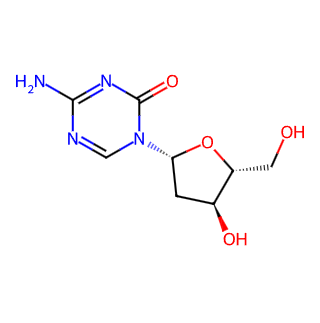- Synthetic anti-infective drugs
- Medications for the digestive system
- Antipyretic and analgesic drugs
- Medications for the blood system
- Medications for the respiratory system
- Anti-allergic drugs
- Medications for the urinary system
- Diagnostic medications
- Immunosuppressive and immunomodulatory drugs
- Vitamins and mineral supplements
- Antioxidants and medications for osteoporosis
- Antiparasitic drugs
- Ophthalmic medications
- Amino acids and their derivatives
- Dermatological medications
- Medications for the circulatory system
- Antitumor drugs
- Medications for the nervous system
- Hormonal and endocrine function-regulating drugs
- Antibiotics
- Others
CAS NO.: 2353-33-5




Decitabine
Basic Information:
English Name: Decitabine
Alternative Names: 5-Azacytidine, 5-Aza-2'-deoxycytidine, etc.
CAS Number: 2353-33-5
Molecular Formula: C8H12N4O4
Molecular Weight: 228.20500
Drug Characteristics:
Type of Drug: Decitabine is a natural adenosine analogue of 2′-deoxycytidine with potential anticancer activity.
Mechanism of Action: It inhibits DNA methyltransferases, reducing DNA methylation, thereby inhibiting tumor cell proliferation and preventing the development of drug resistance. It is currently known as one of the strongest specific inhibitors of DNA methylation.
Mode of Action: After phosphorylation, Decitabine directly acts on DNA, inhibiting DNA methyltransferases, causing hypomethylation of DNA, which in turn induces cellular differentiation or apoptosis.
Clinical Applications:
Primary Indication: Decitabine is indicated for the treatment of myelodysplastic syndromes (MDS). MDS is a heterogeneous group of hematopoietic stem cell disorders characterized by variable blood abnormalities. By demethylation, Decitabine activates tumor suppressor genes and enhances the expression of regulatory genes such as differentiation genes, achieving the goal of treating MDS.
Other Applications: Recent studies have shown that Decitabine also exhibits antiproliferative and apoptosis-inducing activity in other types of cancers, such as acute leukemia and anaplastic large cell lymphoma (ALCL).
Adverse Reactions:
Decitabine may cause adverse reactions such as neutropenia, thrombocytopenia, anemia, vomiting, fatigue, fever, cough, nausea, constipation, diarrhea, hyperglycemia, etc.
High doses may cause neurotoxicity manifesting as lethargy, aphasia, hemiplegia, etc., which can resolve after discontinuation.
Storage and Transportation:
Storage Conditions: Decitabine should be stored in a well-ventilated, cool, and dry environment, avoiding mixing with food ingredients. It is recommended to store it at -20°C after subpackaging, keeping it dry and avoiding repeated freeze-thaw cycles.
Transportation Conditions: Maintain low temperatures during transportation, using ice packs if necessary.

Tai Yau Street, San Po Kong, Kowloon, Hong Kong, China.



